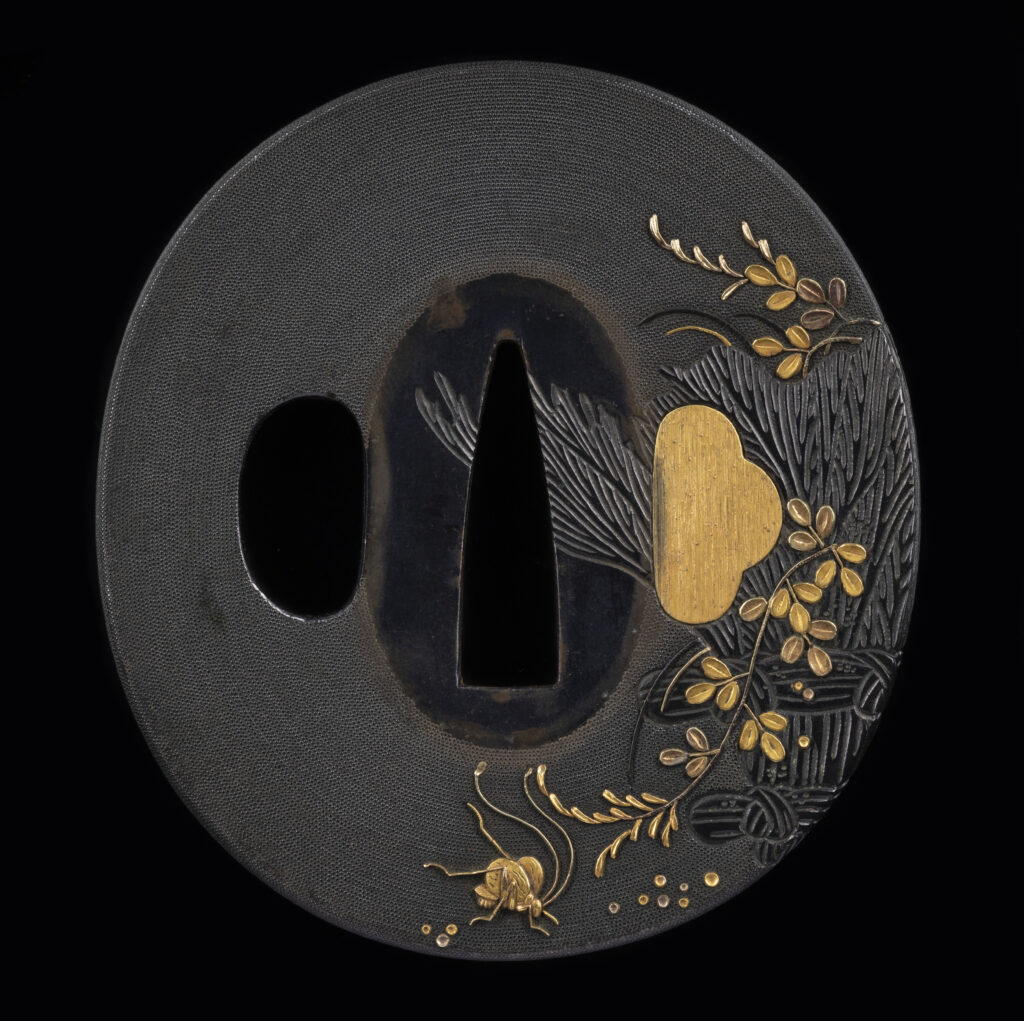Reduced!
Owari Kinko Tsuba
NBTHK Hozon Tosogu
Owari province carries a long history reaching back as early as the 4th century, but is most notable for being the birthplace of Japans “Great Unifier”, Oda Nobunaga in Nagoya in the year 1534. Under Nobunaga’s heavy-handed and merciless methods the various feuding familial and internal provincial factions were eventually quelled and thus he could turn his attentions to the warlords in adjacent provinces. Nobunaga was quick and willing to adopt new types of weapons and strategies that would dominate the battlefield and conquer rivals. He enthusiastically integrated, organized, and employed companies of men with matchlock guns into his armies soon after they arrived in Japan, and without concern for any perceptions of them being a less honorable weapon by warrior tradition.
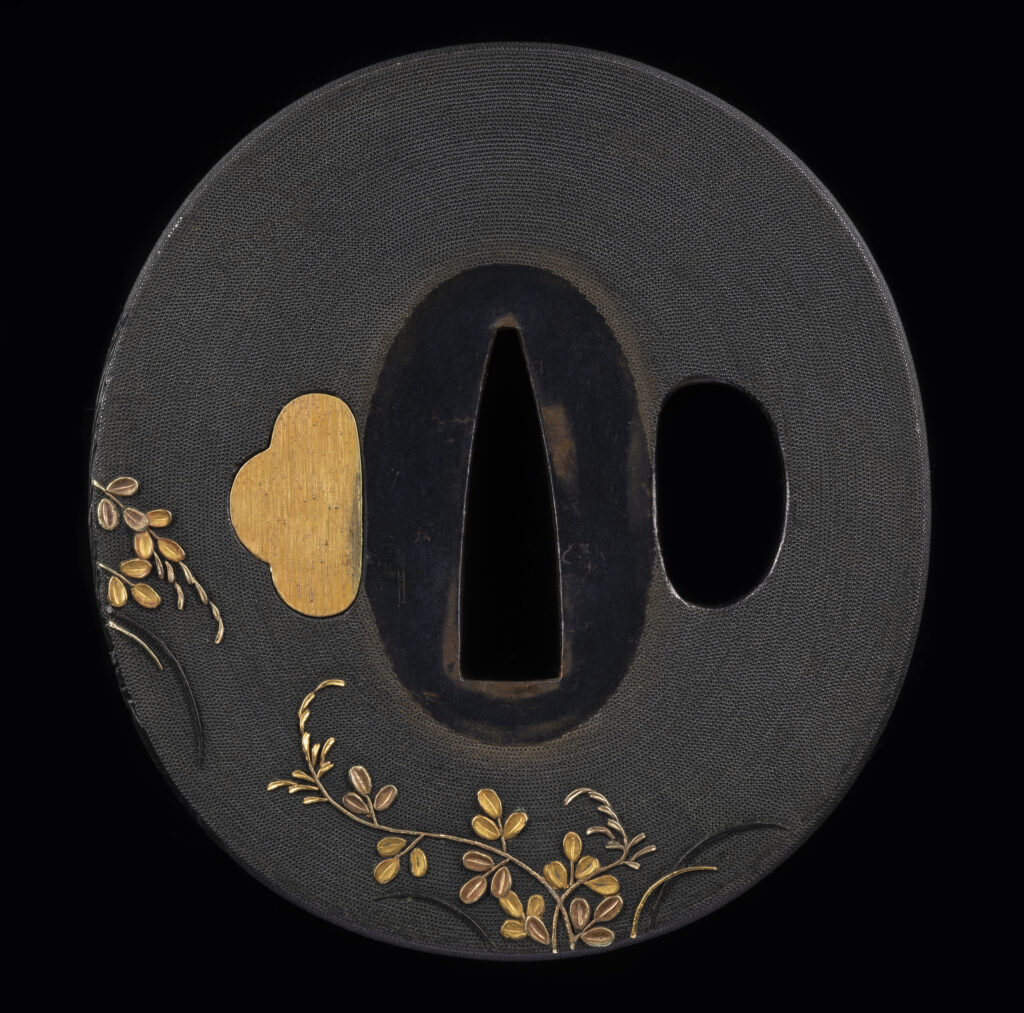
In 1561, Oda Nobunaga conquered the adjacent Mino province wherein lay a thriving center of sword production. Not only did Nobunaga effectively gain control of this production for his own use, but this enabled the relocation of many Mino/Seki sword smiths from the region back to his home province of Owari, thus eventually establishing the foundations for the “Owari Seki” school of sword production.
Nobunaga had already conquered Kiyosu castle in 1555, and administrated significant changes to the economic environment there. He abolished the monopolistic guild structure and relaxed the regulations on merchants and craftsman through a more laissez faire type policy that enabled greater economic prosperity. Kiyosu became a concentrated site of production and markets. It is therefore plausible that some fittings makers working in the Mino Province also immigrated to Owari, bringing with them the techniques and traditions of their repertoire.
There are very few examples of Owari Kinko works, and even less solid information. The most commonly encountered Owari based fittings are the Iron sukashi tsuba of early origination from the region, with references to other tsuba making schools and lines such as Hoan, Yagyu, and Norisuke . But the Tsuba maker that is regarded as perhaps the greatest of all Japanese sword history also resided in Owari; the imminent Nobuie whom lived and worked in Kiyosu during Nobunaga’s reign.
Since Owari was recognized to be largely militaristic by nature, preferences for practical combat koshirae over ostentatious display would logically preferred by the Bushi of the domain. The popularity of iron tsuba is evident by the sheer quantities produced by the makers in Owari.
In the “martial oriented” province of Owari, iron tsuba were of course preferred, and the attitude prevailing there had a major influence in the style of the tsuba that they produced. In general, a certain refusal of warriors against using Kinko-tsuba can be observed. As a result, most kinko-tsuba are wakizashi-tsuba and were mounted on the swords of wealthy merchants or high-ranking “civilian” persons.
Yasukazu Okamoto, Owari to Mikawa Tanko
The focus of the Bushi for iron tsuba, minimized demand for kinko-tsuba, and to a greater or lesser degree were probably even disdained. Craftsmen working in non-ferrous materials would naturally focus their attentions to making other tosogu such as fuchigashira, menuki, and kozuka. Eventually, kinko-tsuba emerged in Owari and began to grow in demand as the prosperity of the merchant class gained influence, and the Owari Tokugawa patronized kinko craftsmen that could produce the decorative and flourished tosogu more fitting to their rank and stature. Enter the two shadowy groups of fittings makers known as the “Kozenji” and the “Ikkodo” schools in Owari.
Records and extant works of the Ikkodo and Kozenji schools are scant. Most fittings were unsigned, and compounding the difficulties of attribution were that most makers are unrecorded in general resources, and those makers that do have some signed works and/or are recorded, have little to nothing known of their lineages. Other schools and makers that worked for Owari patrons, worked either transiently in Owari or remotely from it.
Of the Ikkodo and Kozenji schools, there are extant Ikkodo zaimei works, but Kozenji works are unsigned. Ikkodo school makers such as Tomotsugu, Tomoyasu, and Motoyasu , are regarded as having produced some excellent works in signed examples. They worked in a diverse range of styles, including sukashibori-iroe, takabori-iroe, and some unsigned Ikkodo works could be mistaken for the Kozenji school. The influence of Mino designs such as Akikusa, insects, and flora, were a part of their general repertoire. This also provides some credence that the makers in Owari worked in stylistic approaches to produce a local interpretations inspired by the Mino province that Oda Nobunaga had swept into his dominion in the late 16th century.
The Kozenji school also worked in a large variety of styles many of which also modeled on Mino-Goto, or Mino-bori. However their more dominant production was that of hirazogan that so greatly resembles Kaga hirazogan, that Kozenji pieces are understandably mistaken for Kaga works. The best of Kozenji works in hirazogan are indeed remarkable and every bit as skilled and refined as Kaga works. The origin of the school name likely derived from the location at the Kozenji temple, and it would also explain why their works were mumei, as items made at or on temple grounds have historically been largely left unsigned such as in the Yamato tradition sword forges in Nara. There are curious notations in some Edo period manuscripts that allude to kaga-zogan craftsman coming to Owari from Kaga, but they are only identified by given names so their family names are not known. This does further support the suspicion that Kaga makers were integrated into Kozenji and perhaps Ikkudo schools whom were also trained by, or were themselves, transplants from Mino province, establishing the unique appearance of Owari works.
Yet another maker, Hasegawa Katsuaki emerged around the late Edo/Bakamatsu period. Katsuaki himself was born in Gifu, Mino, and became a student of his uncle, the Nidai Norisuke who lived in Nagoya, Owari. Extant tsuba by Katsuaki demonstrate flat inlays, again much like the Kozenji, Kaga, and Umetada schools, but with more engraved details flourishing his works that certainly would have been appreciated by his patrons, the Owari branch of the mainline Tokugawa Shogunate.
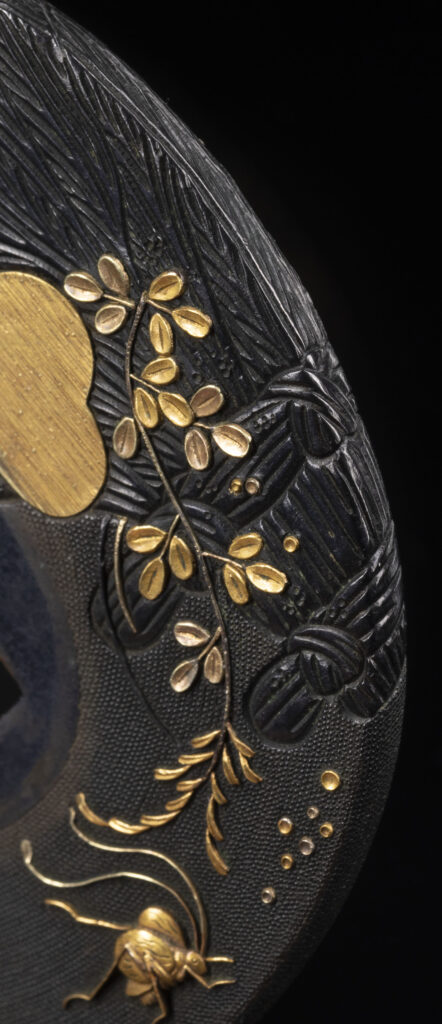
Owari Kinko works are thus a bit obscure, and this one is additionally a bit more mysterious as the overall plate is worked in nicely patterned nanako, on top of which is finely executed on-lay work, and yet another technique of kebori engraving of bundled branches. These three techniques are integrated between each other so that they are quite harmonious, bringing depth of view and dimension to the work, while maintaining a rather low profile to the finished work. So what we can say from both this work, and at least that of Kinko works from Owari, is that the style was a bit of the fusion of other styles from other makers, schools, and provinces. Given the diversity that Nobunaga’s conquests and policies brought to his domain, it would seem logical that a wide array of influences would be adopted and employed by the craftsmen working for him, and for the subsequent Tokugawa lords after him.
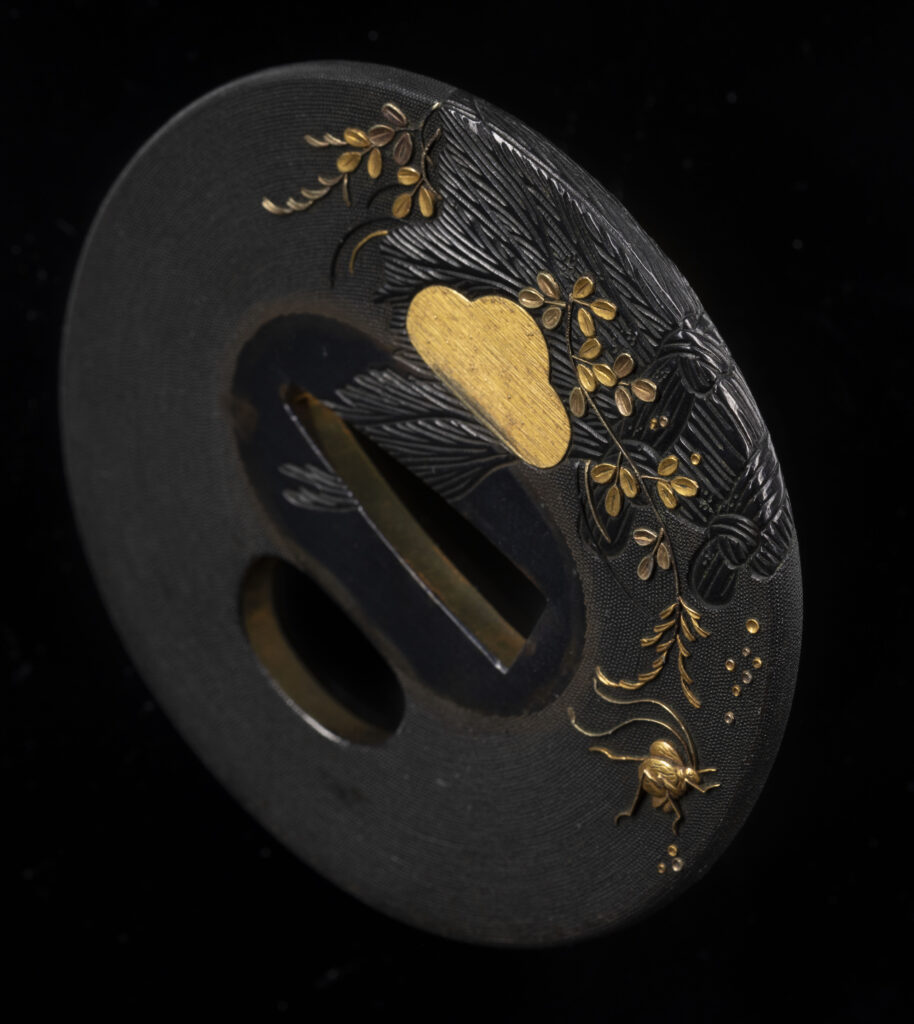
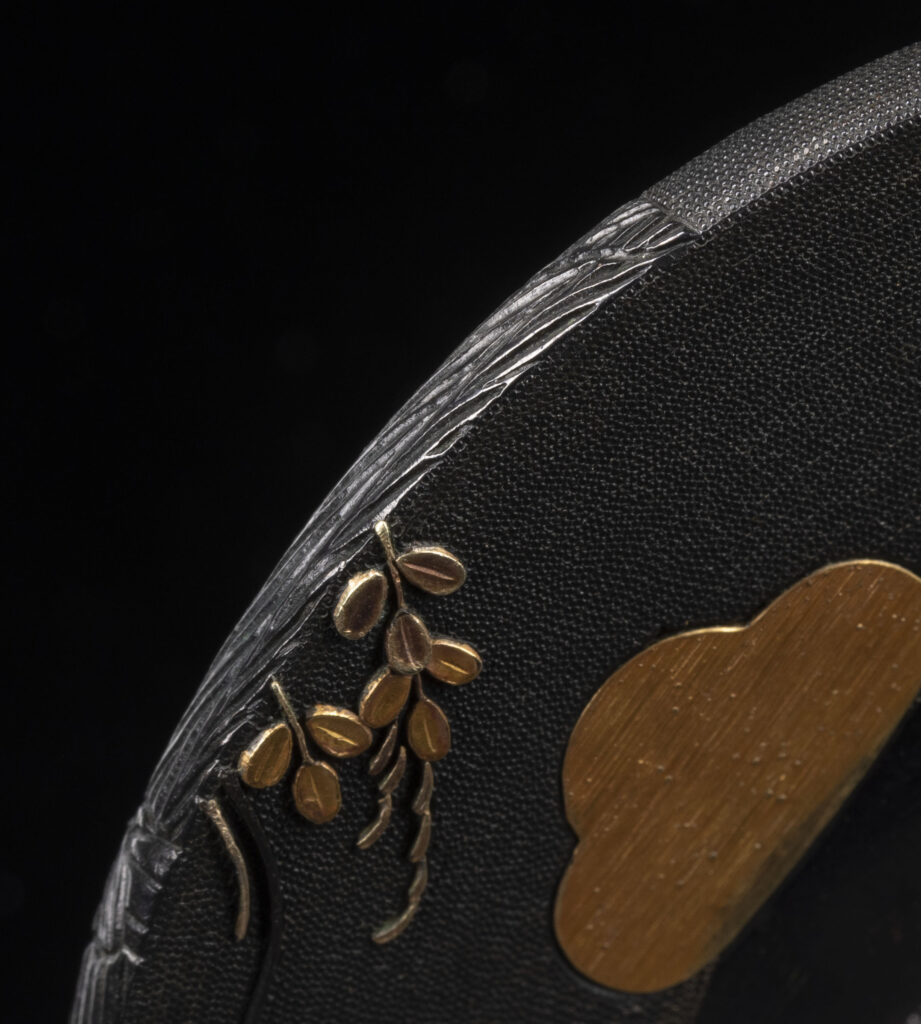
The impression gleaned from this tsuba is that of a Mino influenced design, with perhaps some inspirations derived from Goto and maybe some engraving approaches to those of Satsuma. It is a rather intriguing mix, and a skilled work in all regards, with both the nanako and kebori work carried over and onto the rim without awkwardness or interruption. The detail of the branches continuing into the seppadai is also quite unusual and not often seen. This piece was clearly mounted previously, and the seppa have left a couple of minor blemishes to the details and patina adjacent to the seppadai. These are not too distracting, and regardless of them, the condition is very good.
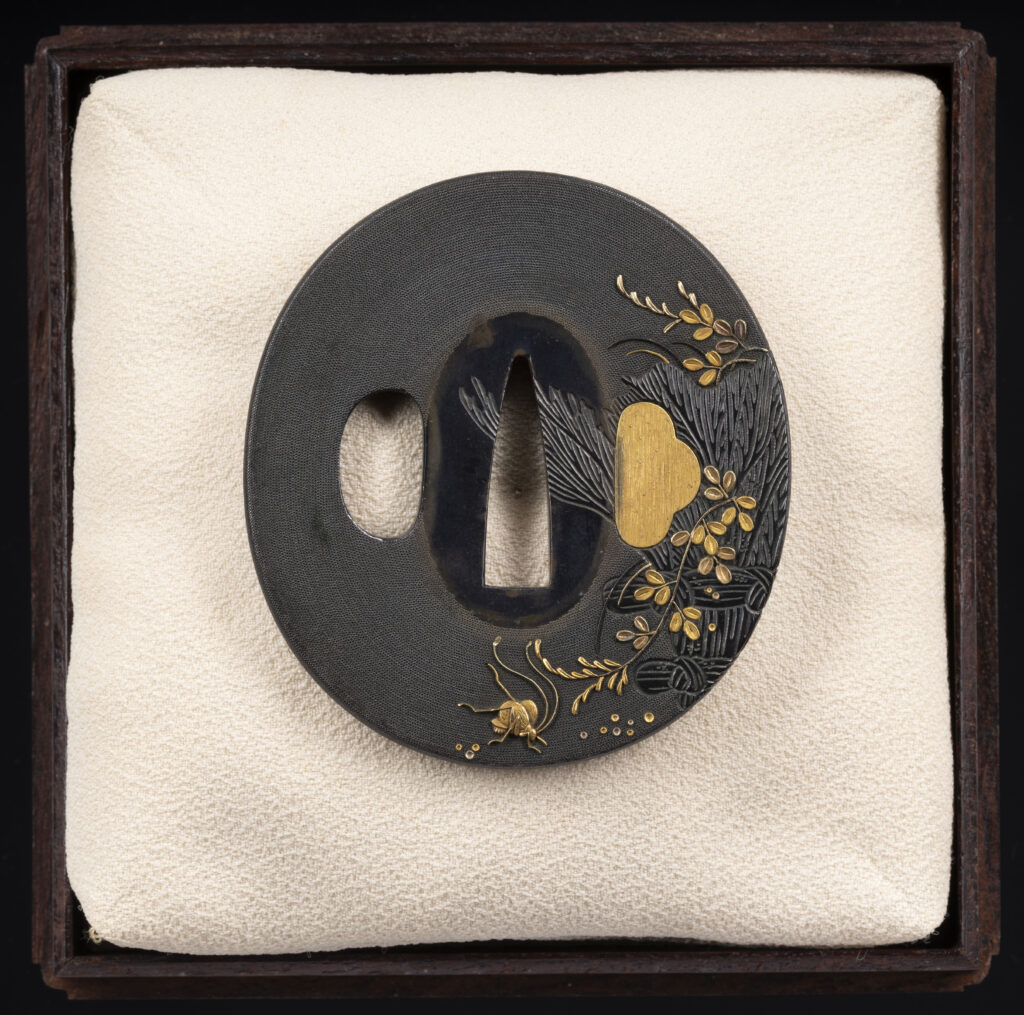
This tsuba is accompanied by an NBTHK Hozon Tosogu certificate, and held in a custom hardwood box which I think may be made of Persimmon wood. This is a rare and unusual specimen of Owari Kinko craftsmanship and in very nice condition. It would be a great addition to a collection.
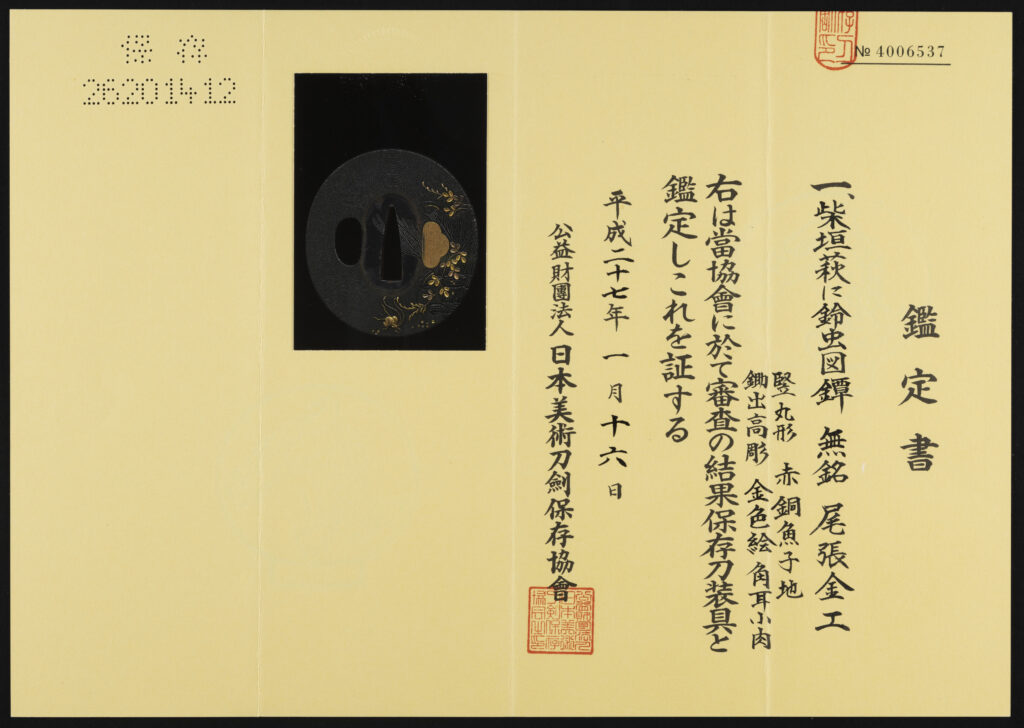
Dimensions: 6.85 cm x 6.3 cm x 4 mm
On Consignment: Reduced! Now $2,500.00 USD
